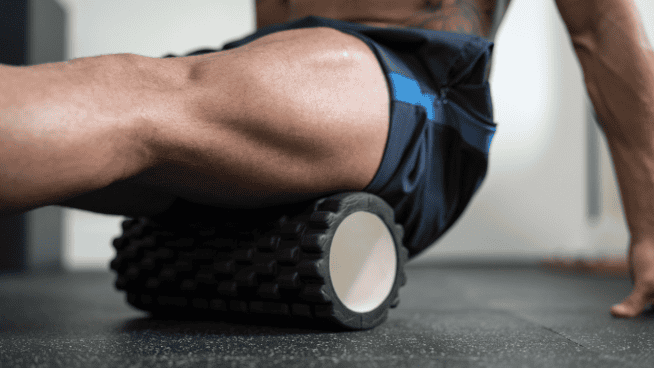Build Strong Rear Delts With the Bent-Over Lateral Raise
[youtube video=”xavxTEGOf4g” /]
The Bent-Over Lateral raise is an exercise used to build strength and size of the rear delt, a muscle on the backside of the shoulder. Historically, the exercise was used by bodybuilders to improve their backside poses on the stage, but this exercise has many benefits outside of aesthetics, including improved strength, shoulder health and posture.
In this article, we’ll explain how to perform the exercise properly and avoid common mistakes to build strong and healthy shoulders.
- What’s the Difference Between the Bent-Over Lateral Raise and the Rear Delt Raise?
- Bent-Over Lateral Raise Form
- Bent-Over Lateral Raise Mistakes
- Bent-Over Lateral Raise Benefits
- Bent-Over Lateral Raise Muscles Worked
- Bent-Over Lateral Raise Alternatives and Variations
- Bent-Over Lateral Raise Workouts
What’s the Difference Between the Bent-Over Lateral Raise and the Rear Delt Raise?
The Bent-Over Lateral Raise and Rear Delt Raise are the same exercise. The names are used interchangeably by different coaches and educational resources. This exercise is different from the standard Lateral Raise, which is performed standing upright and targets the lateral portion of the deltoid muscle.
Bent-Over Lateral Raise Form
Step 1: Stand with your feet hip-width apart holding dumbbells in both hands at your sides. Bend at your waist and slightly bend your knees to lean over until your torso is nearly parallel the ground similar to the Barbell Bent-Over Row. Your arms should hang below your shoulders with your elbows slightly bent.
Step 2: With your core tight and back flat. Raise the dumbbells to the sides until your elbows are in line with your shoulders. Your pinky should be slightly higher than your thumb as if you were pouring liquid out of the dumbbell.
Step 3: Lower the dumbbells in control to the starting position and repeat.
Bent-Over Lateral Raise Mistakes
Here’s how to avoid several common Bent-Over Lateral Raise Mistakes:
Bouncing
Nine times out of 10 people use too heavy of a weight, causing rocking and swinging. This makes it a momentum exercise and doesn’t sufficiently challenge the rear delt. It also takes the dumbbells out of the ideal path to safely work your upper back and rear delts.
The Fix: First and foremost, use a lighter weight. If that doesn’t work, lay your forehead on a flat object like a plyo box. If you happen to have that unwanted rocking of the torso, your forehead will lift off the bench, which makes it easy to catch.
Lifting at an Angle
If your arms are at an angle with your torso, you’re turning this into a back exercise that works the lats and other large back muscles rather than your rear delt.
The Fix: Make sure the motion of your arms are perpendicular to your torso. This keeps the lats from taking over the movement.
Performing Low Reps With Heavy Weights
This isn’t meant to be a heavy strength exercise like a Shoulder Press. That simply leads to bouncing and will end up targeting the large back muscles rather than the rear delt.
The Fix: Perform reps ranging from 15-25 reps with a light weight so you can perform each rep in control and effectively strengthen the rear delt.
Bent-Over Lateral Raise Benefits
The backside of the shoulder and upper back must be strong for athletic performance. These muscles help stabilize the shoulder, maintain posture and create balanced strength for those who like to perform a lot of pressing work. You won’t schedule this as a main lift. It’s an assistance exercise meant to complement your primary exercises.
Bent-Over Lateral Raise Muscles Worked
Bent-Over Lateral Raises work the posterior deltoid, which the part of the deltoid that’s on the backside of your shoulder. It also works other large muscles in your back, but the posterior delt is the focus of the exercise.
Bent-Over Lateral Raise Alternatives and Variations
Prone Rear Delt Raise
This version limits the potential for rocking, helping to isolate the rear delt.
[youtube video=”XIJTt_Czqmc” /]Seated Rear Delt Raise
The seated position is a bit easier to perform and is a perfect option for following an intense back workout.
[youtube video=”tjMO4doEaOQ” /]
Banded Rear Delt Fly
Using a band challenges the rear delt through the entire range of motion of the exercise and is a joint friendly method for developing shoulder strength.
[youtube video=”O6d4uOqQLMw” /]
Bent-Over Lateral Raise Workouts
Bent-Over Lateral Raise Workout
1) Bent-Over Lateral Raise – 3×20
Bent-Over Lateral Raise Superset Workout
1A) Bent-Over Lateral Raise – 3×20
1B) Push-Ups – 3×12
Bent-Over Lateral Raise Upper-Body Workout
1) Bench Press – 5×3
2) Barbell Rows – 5×5
3A) Slight-Incline Dumbbell Press – 4×10
3B) Pull-Ups – 4×8-10
4) Bent-Over Lateral Raise – 4×15
5A) Skull Crushers – 3×12
5B) Hammer Curls – 3×15
READ MORE:
- 5 Bodyweight Exercises to Strengthen Your Shoulders
- The Most Effective Way to Build Strong and Pain-free Shoulders
- 5 Rear Delt Exercises for Strong and Durable Shoulders
[cf]skyword_tracking_tag[/cf]
RECOMMENDED FOR YOU
MOST POPULAR
Build Strong Rear Delts With the Bent-Over Lateral Raise
[youtube video=”xavxTEGOf4g” /]
The Bent-Over Lateral raise is an exercise used to build strength and size of the rear delt, a muscle on the backside of the shoulder. Historically, the exercise was used by bodybuilders to improve their backside poses on the stage, but this exercise has many benefits outside of aesthetics, including improved strength, shoulder health and posture.
In this article, we’ll explain how to perform the exercise properly and avoid common mistakes to build strong and healthy shoulders.
- What’s the Difference Between the Bent-Over Lateral Raise and the Rear Delt Raise?
- Bent-Over Lateral Raise Form
- Bent-Over Lateral Raise Mistakes
- Bent-Over Lateral Raise Benefits
- Bent-Over Lateral Raise Muscles Worked
- Bent-Over Lateral Raise Alternatives and Variations
- Bent-Over Lateral Raise Workouts
What’s the Difference Between the Bent-Over Lateral Raise and the Rear Delt Raise?
The Bent-Over Lateral Raise and Rear Delt Raise are the same exercise. The names are used interchangeably by different coaches and educational resources. This exercise is different from the standard Lateral Raise, which is performed standing upright and targets the lateral portion of the deltoid muscle.
Bent-Over Lateral Raise Form
Step 1: Stand with your feet hip-width apart holding dumbbells in both hands at your sides. Bend at your waist and slightly bend your knees to lean over until your torso is nearly parallel the ground similar to the Barbell Bent-Over Row. Your arms should hang below your shoulders with your elbows slightly bent.
Step 2: With your core tight and back flat. Raise the dumbbells to the sides until your elbows are in line with your shoulders. Your pinky should be slightly higher than your thumb as if you were pouring liquid out of the dumbbell.
Step 3: Lower the dumbbells in control to the starting position and repeat.
Bent-Over Lateral Raise Mistakes
Here’s how to avoid several common Bent-Over Lateral Raise Mistakes:
Bouncing
Nine times out of 10 people use too heavy of a weight, causing rocking and swinging. This makes it a momentum exercise and doesn’t sufficiently challenge the rear delt. It also takes the dumbbells out of the ideal path to safely work your upper back and rear delts.
The Fix: First and foremost, use a lighter weight. If that doesn’t work, lay your forehead on a flat object like a plyo box. If you happen to have that unwanted rocking of the torso, your forehead will lift off the bench, which makes it easy to catch.
Lifting at an Angle
If your arms are at an angle with your torso, you’re turning this into a back exercise that works the lats and other large back muscles rather than your rear delt.
The Fix: Make sure the motion of your arms are perpendicular to your torso. This keeps the lats from taking over the movement.
Performing Low Reps With Heavy Weights
This isn’t meant to be a heavy strength exercise like a Shoulder Press. That simply leads to bouncing and will end up targeting the large back muscles rather than the rear delt.
The Fix: Perform reps ranging from 15-25 reps with a light weight so you can perform each rep in control and effectively strengthen the rear delt.
Bent-Over Lateral Raise Benefits
The backside of the shoulder and upper back must be strong for athletic performance. These muscles help stabilize the shoulder, maintain posture and create balanced strength for those who like to perform a lot of pressing work. You won’t schedule this as a main lift. It’s an assistance exercise meant to complement your primary exercises.
Bent-Over Lateral Raise Muscles Worked
Bent-Over Lateral Raises work the posterior deltoid, which the part of the deltoid that’s on the backside of your shoulder. It also works other large muscles in your back, but the posterior delt is the focus of the exercise.
Bent-Over Lateral Raise Alternatives and Variations
Prone Rear Delt Raise
This version limits the potential for rocking, helping to isolate the rear delt.
[youtube video=”XIJTt_Czqmc” /]Seated Rear Delt Raise
The seated position is a bit easier to perform and is a perfect option for following an intense back workout.
[youtube video=”tjMO4doEaOQ” /]
Banded Rear Delt Fly
Using a band challenges the rear delt through the entire range of motion of the exercise and is a joint friendly method for developing shoulder strength.
[youtube video=”O6d4uOqQLMw” /]
Bent-Over Lateral Raise Workouts
Bent-Over Lateral Raise Workout
1) Bent-Over Lateral Raise – 3×20
Bent-Over Lateral Raise Superset Workout
1A) Bent-Over Lateral Raise – 3×20
1B) Push-Ups – 3×12
Bent-Over Lateral Raise Upper-Body Workout
1) Bench Press – 5×3
2) Barbell Rows – 5×5
3A) Slight-Incline Dumbbell Press – 4×10
3B) Pull-Ups – 4×8-10
4) Bent-Over Lateral Raise – 4×15
5A) Skull Crushers – 3×12
5B) Hammer Curls – 3×15
READ MORE:
- 5 Bodyweight Exercises to Strengthen Your Shoulders
- The Most Effective Way to Build Strong and Pain-free Shoulders
- 5 Rear Delt Exercises for Strong and Durable Shoulders
[cf]skyword_tracking_tag[/cf]















